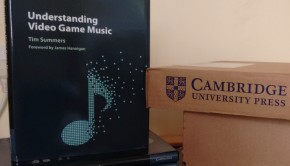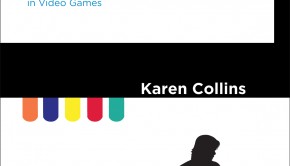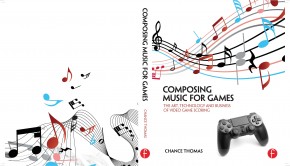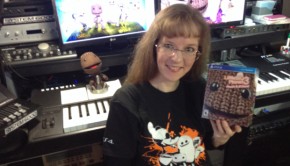Karen Collins Interview: An Academic Perspective on Game Sound
One perspective from which game sound has so far rarely been looked at is through the lens of systematic, academic research. Academia has been slow to pick up the analysis of game sound as a topic worthy of consideration, but the last decade has seen significant progress. One of the pioneers in the field is Karen Collins, editor of From Pac-Man to Pop Music and author of Game Sound, possibly the first academic tome dedicated solely to game sound.
In this fascinating interview, Collins describes her motivation for starting out in what was back then a very new and often misunderstood field of research, and how its standing has changed in the past decade. Collins discusses the major theories behind her research, which touch upon the very nature of game sound as being dynamic and adaptive. She also shares her thoughts on the current state of game sound creation and where this constantly evolving art might be headed in the future.
Interview Credits
Interview Subject: Karen Collins
Interviewer: Simon Elchlepp
Editor: Simon Elchlepp, Chris Greening
Coordination: Simon Elchlepp
Interview Content
Simon: Karen Collins, thanks for taking the time today to talk about your work. To start things off, could you give us some information about how your interest in game sound began? When and how did this interest turn into a more serious concern of yours that led you to start researching game sound after your PhD in music?
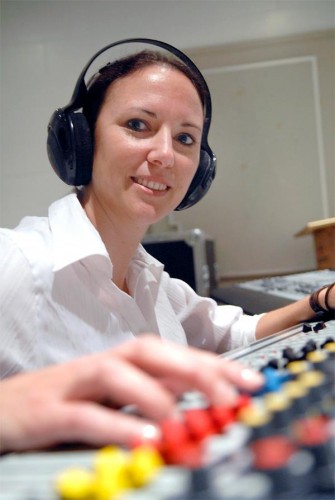
Karen Collins: It was actually during my PhD that I began thinking about it seriously. I was researching industrial music, and there are a lot of minor seconds in that music. I was trying to figure out why. Then I remembered playing old video games when I was a kid and hearing the same thing, so I went back to the old Atari 2600 and looked into why there were all these minor seconds, which was an anomaly of the tuning on that console. I was so excited about game music, I used it to motivate me to finish my PhD, so that I could turn my attention to that instead! I knew I’d get some push-back from my colleagues — in fact, some people actually laughed at me, but that was ten years ago, and now it’s much more accepted.
Simon: As you point out in your books, academia has been slow to pick up game sound as a research field of interest. In how far do you think this has to do with preconceived notions of video games as being less ‘worthy’ of academic analysis, or is it also a matter of many academics simply being unfamiliar with both the musical and technical aspects of game sound?
Karen Collins: I think there’s a little of both happening. Popular music in general is less respected than classical music in the academy. Music departments are probably the most conservative departments you can find. But a lot of academics who don’t have kids and just aren’t exposed to games think that the music still sounds like old 8-bit stuff. They don’t realise how much game music has progressed. Not that I think 8-bit music isn’t worthy — it’s my favourite, and I think there’s lots of interesting things still to be said about it! The other aspect is that music scholars aren’t often trained in the technological side of things. We generally don’t get trained in the audio engineering side of things, and certainly we don’t get trained in game engines or programming, so I think in part game music was left out for a while because it was just a whole other ‘language’ to learn for anyone wanting to get into that.
Simon: Given how little academic work on game sound there was when you started your research into it, and how different game sound is in its use from sound in other media, where did you start your research and how did you formulate your research goals? How much has the direction of your research changed over the years?
Karen Collins: Initially I didn’t really have any goals. I just wanted to put together a solid history that would help other scholars to learn about how it all worked. I worked in IT during and after my PhD, and I’ve always been a bit of a geek, so it was easier for me to pick up on the technical aspects and write about that. I’ve veered away from that in my most recent work, which is in a new book coming out on MIT Press in a few months, called Playing With Sound. In the new work, I’ve looked at how players interact with game sound, what they do with it, and what it means in the context of a game. It’s more academic, but I hope it’s still accessible to most readers and that it still gets people thinking about game sound in new ways.
I guess my mission has always been to try to get this music exposed in scholarly circles and beyond, to have people appreciate it more. I think I might go back to the history again now, though. It’s what I still play and still listen to the most, and I think we need to go back and interview all the original composers and document as much as we can while they’re still around.

Simon: In these early days of your research, how easy or difficult did you find it to communicate your work to colleagues within academia and engage in discussions that would further your analysis? How important was your discourse with figures from the game music industry and what impulses did this discourse between science and industry give to your research?
Karen Collins: I really didn’t talk about it much to colleagues. My post-doc supervisor was pretty good at helping me formulate the argument and push my work further, but it was so new then that it was difficult to find people to bounce ideas off inside the academy. I hung out with a lot of people that work in games, and went to all the major conferences and got to know industry people, which helped a lot. These guys were always happy to talk about their work, share their ideas. They’re a fantastic bunch of people working in this industry!
Simon: In one way, research into game sound is facilitated by the fact that so many games and their soundtracks are well documented and accessible via dedicated websites and other sources. On the other hand, this also means that there is an overwhelming amount of content to analyse out there. How did you tackle this mountain of material and how did your research then enable you to make quite encompassing assessments? (for example the “progressive-rock stylistic traits” of the Sega Genesis).
Karen Collins: Well, I began over ten years ago now, and there wasn’t that much online back then. It was a lot of digging and just going from each console and playing the games, deciding which ones to focus on. Game Sound took about five years to research, so I just played as many games as I could, thought about them, and wrote down my thoughts.
Simon: You correctly point out in your work that technical limitations have been one decisive factor in shaping the nature of game sound throughout console generations. How difficult did you find it to work your way into the technological background of various kinds of computers and video game consoles? Do you think such technical limitations still play a role in the context of the current console generation and the lifelike sounds these devices can produce?
Karen Collins: I found the technical constraints the most interesting part of early game music. I went to a job interview and said I was working on game music and they laughed and said that “it’s so simple”. But it’s the opposite, because there’s so much to take into consideration when looking at this music. I lucked out at one point because someone in Ottawa, Canada was moving to San Francisco and he had amassed all these old computers and was giving them away on Craig’s list. I got there a few hours before he moved, in a borrowed Toyota Echo, and packed every inch of this car down in old Amigas and 64s. It was a great resource to have all of the original machines to play. They all worked. I wish I’d gotten the guy’s name, because I owe him a big thanks!
There are still limitations, but much less than before. I mean, the palette of sounds has expanded tremendously, but the memory budgets for audio are still constraining. That means that a beautiful multi-channel mix might get compressed down to stereo, and it’s a shame.
Simon: Your first two published books were From Pac-Man to Pop Music, which you edited, and Game Sound. Again, as there weren’t many other academic books written on the subject, how did you conceptualise both works and how did you choose your collaborators on From Pac-Man to Pop Music? What was your aim for Game Sound, given that it was a quite a pioneering work as one of the first academic books dedicated to game sound?
Karen Collins: Game Sound‘s aim was just to provide a foundation, so other scholars had something to start from if they wanted to look at game sound at all, because there really wasn’t anything else out there. From Pac-Man to Pop Music began by just sending out emails and asking people if they could write something. It was good to get industry people involved, so they could share their perspective. I’m working on another collection now, The Oxford Handbook of Interactive Audio, and we have some game industry folks writing a few chapters for that. I think it’s important that they get their voices out there, because they’re the ones in the trenches doing the work.

Simon: Focusing more on Game Sound, its main topic which runs through the whole work is the concept of dynamic audio, and the possibilities it offers game creators. For our readers who are unfamiliar with your work, could you give a short summary of what dynamic audio is, why you decided to focus your research on it, and the benefits it offers?
Karen Collins: Dynamic audio is what differentiates game sound from film — it’s the fact that people interact with the sound, and that the sound is constantly evolving based on game parameters. A game is never exactly the same twice, whereas a film will be the same each time you play it though. I think it’s a really interesting problem for scholars, because the whole history of music has focused on linear music that’s always the same, with the exception of some experiments and avant-garde work. There really isn’t a language to talk about it, so it means we can be pioneers in talking about this type of sound. For composers, it’s a whole new way of thinking about music. It requires a really different skill-set, a really creative mind.
Simon: One central theory postulated in Game Sound is that game creators should attempt to make more use of dynamic audio, which adapts to gamers’ actions and the state of their avatar, as opposed to using music that simply loops in the background regardless of what happens on the screen. However, many gamers’ recall the mostly non-adaptive and repetitive music from earlier console generations very fondly, and many indie games released in the last few years seek out this kind of ‘chiptunes’ sound. I was wondering in how far certain groups of gamers might accept repetitive, largely non-adaptive music as part of the medium’s artifice and actively enjoy it — similar to how one might accept the theatrical acting style of silent movies simply as a given, or the slow, decidedly un-lifelike pacing of many operas?
Karen Collins: Well, I love the old music, too, but I don’t think you have to lose the entire aesthetic to make it more interesting. I think there’s a time and place for the repetition and looping. It works in some games, particularly when you’re drawing on the nostalgia, but in other games, it just doesn’t work. If you’ve got really life-like graphics and you’re aiming to create an interactive movie, having really repetitive music won’t sit well, but if your game is calling on older game aesthetics or is really minimalist, it might work a lot better.
Simon: One of the venues that you identify in Game Sound for dynamic audio to explore are MIDI sounds, which have overcome the technical limitations of yesteryear and are more adaptable than pre-recorded orchestral music. At the same time, lavish orchestral scores are now written even for mobile games like Horn. Do you feel that this focus on film score-inspired, orchestral game music hinders game creators from looking more closely at the possibilities dynamic game sound offers?
Karen Collins: Well, as with the repetition, I think there’s a time and place for everything. I think trying to make games like interactive movies sometimes does a disservice to the medium. It’s kind of like Hollywood just recycling the same ideas over and over. Then you get an indie game that’s not cinematic at all, that really pushes the boundaries of the medium, and it becomes a hit. I think there’s a place for both a cinematic style and a style that really drives new game ideas. It’s the same with music — orchestral linear scores might have a place, but so does really interactive, dynamic music.
Simon: While adaptive game music has made significant advances in the last decades, on a standalone basis — on album or during concerts — game music is still presented as a linear succession of compositions with a discrete beginning and end, losing almost all of it dynamic nature. Do you feel that current ways of presenting game music outside of games sells short the art form’s creative potential? Do you think alternative ways of showcasing game music that highlight its adaptive nature better might emerge in the future?
Karen Collins: Ha ha… absolutely! I’m laughing because I’m working on this right now, and going to pitch it as a workgroup topic for Project Bar-B-Q this year, which is an annual interactive audio think tank. I think it’s time for a more dynamic play-back system so that game music can really be showcased in the way it’s meant to be heard.
Simon: To draw the interview to a close, it would be interesting to hear from you how both academic research into game sound and the development of more dynamic game audio have come along since you published Game Sound in 2008?
Karen Collins: I think game sound is finally getting real recognition in the academy. We’re not having to argue that it’s relevant or important anymore. We’ve finally got people listening, and there’s even some courses you can take now at universities, which is great. I think the industry is also moving ahead a lot.
There’s a handful of people that really try to push boundaries. Every time they put a game out, they want something new that hasn’t been done before, and it’s really exciting. There’s a lot more player participation in music, like with LittleBigPlanet 2‘s sequencer, which is great. There’s still so much energy in the industry — the composers and sound designers are all so enthusiastic. A lot of them keep writing about their work, sharing their ideas, like Damian Kastbauer who writes for Designing Sound, and Rob Bridgett, who writes a lot about mixing and sound design. It’s amazing that these guys take the time out to do all this extra work for free, to try to cultivate a real skill and talent amongst people breaking into the industry.

Simon: In which direction is your own research heading, and can we expect further publications from you in the near future?
Karen Collins: I’ve got two books coming out soon, as I mentioned before. Playing With Sound will be out in a few months on MIT Press, and The Oxford Handbook of Interactive Audio will probably take another year or so. It’s a huge volume, of about 40 chapters. Besides editing that, I started a company called Veemix, which is creating software to enable user-generated music content in games, and then sharing that content over a social network. I’m also working on a couple of short films, so I’m taking a break from writing right now and having some fun getting my hands “dirty” so to speak.
Simon: After having listened intensely to and analysed what must be a vast number of game music scores, it would very interesting to hear about your favourite genre of game music or maybe even favourite score — you’ve previously hinted at your fondness for 8-bit sounds.
Karen Collins: It’s tricky to pick a favourite, and there’s music that works really well on its own and music that works really well in context. I love the Metroid music, and I listen to that a lot outside of playing the game. Silent Hill, too. I guess I go for more atmospheric and dark music when I want to listen outside of gameplay. In-game, though, there’s nothing that beats Koji Kondo’s music: Super Mario Bros, Zelda… it works so well with the games. I never get tired of that! There’s also a special place in my heart for 8-bit music because I spent an awful lot of my childhood listening to that, but it’s not something I listen to outside of the games very much.
Simon: Many thanks for your time today, Karen Collins. Is there anything else you would like to say about your works and your research?
Karen Collins: It’s great to see so much interest now in game sound, and particularly that scholars have woken up to the fact that we have this great new area of research to pursue. There’s still so much work to do, though, so I encourage anybody who is interested to get involved: Start interviewing, writing, analysing, creating, whatever. Just get involved!
Posted on November 15, 2012 by Simon Elchlepp. Last modified on April 9, 2014.

